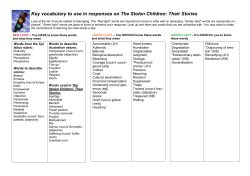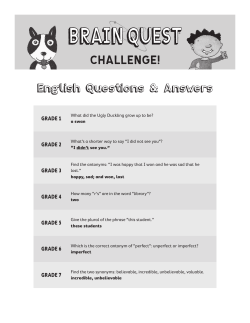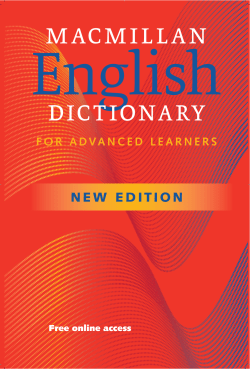
GRAMMATICAL AGREEMENT Edith Moravcsik University of Wisconsin-
GRAMMATICAL AGREEMENT Edith Moravcsik University of WisconsinMilwaukee edith@uwm.edu 1 1. INTRODUCTION GOALS OF THE URALIC TYPOLOGY DATABASE PROJECT Cataloguing grammatical structures of Uralic languages in a database and assessing them relative to other languages of the world TASKS 1/ Cataloguing grammatical structures of Uralic languages in a database 2/ Surveying crosslinguistic generalizations about grammars 3/ Assessing Uralic features in the context of relevant crosslinguistic generalizations; noting similarities and differences in occurrence and frequency 2 GOALS OF THIS PAPER 1/ Re the task of cataloguing grammatical structures of Uralic languages: PROVIDE (a) A DEFINITION OF AGREEMENT and (b) A LIST OF PARAMETERS OF VARIATION (SECTION 2) 2/ Re the task of surveying crosslinguistic generalizations: PROVIDE A SAMPLE OF CROSSLINGUISTIC GENERALIZATIONS ABOUT AGREEMENT (SECTION 3) 3 2. A DEFINITION OF AGEEMENT AND PARAMETERS OF VARIATION SELECTIONAL DEPENDENCY [If A, then B /W] M In context W, if syntactic constituent A has been selected, syntactic constituent B must or may also be selected. 4 GOVERNMENT [If A.X and B, then B-c /W] M In context W, if constituents A and B have been selected and A is of subtype X, B must or may have the case marker c. AGREEMENT [If A.X1 and B, then B-x1 /W] M In context W, if constituents A and B have been selected and A has a given value of the feature X, then B must or may have a marker representing the same value of X. 5 PARAMETERS OF VARIATION IN AGREEMENT CONSTRUCTIONS - A: B: X: W: M: controller target feature context modality 6 SAMPLE DATABASE ENTRIES FOR HUNGARIAN 1/ NOUN-DEMONSTRATIVE AGREEMENT - controller: noun - target: demonstrative pronoun - feature: number, case - context: within the noun phrase - modality: must Example: ez-ek-et a kez-ek-et this-PLU-ACC the hand-PLU-ACC ‘these hands (ACC)’ 7 2/ SUBJECT-VERB AGREEMENT - controller: subject - target: verb - feature: person, number - context: within the clause - modality: must Example: ti olvas-tok you(PL) read-P2 ‘you(PL) read’ 8 3. A SAMPLE OF CROSSLINGUISTIC GENERALIZATIONS ABOUT AGREEMENT Generalizations about (A) INDIVIDUAL TERMS (B) SYNTAGMATIC COOCCURRENCE: the distribution of individual terms relative to each other in an agreement construction (C) PARADIGMATIC COOCCURRENCE – 1: the distribution of agreement patterns relative to each other in a language (D) PARADIGMATIC COOCCURRENCE – 2: the distribution oof agreement patterns relative to other grammatical features in a language 9 (A) GENERALIZATIONS ABOUT INDIVIDUAL TERMS G-1. If a language has an agreement pattern, its terms must be from among those in the crosslinguistic inventory of agreement terms. 10 A crosslinguistic inventory of individual terms of agreement: (a) Controllers: - nominal (noun or pronoun) - noun phrase -- subject -- direct object -- indirect object - possessive adjective - qualitative adjective - verb - finite clause - infinitive 11 (b) Targets: - article - demonstrative - quantifier - adjective - verb - predicate complement - pronoun - adverb - adposition - possessor noun - possessed noun - apposition - complementizer - coordinating conjunction - particle 12 (c) Features: - gender - number - person - case - definiteness - respect - tense, aspect 13 (d) Contexts: - domains: noun phrase clause sentence discourse - conditions: precedence adjacence (e) Modalities: - must - may 14 (B) GENERALIZATIONS ABOUT THE DISTRIBUTION OF INDIVIDUAL TERMS RELATIVE TO EACH OTHER G-2. If a language has an agreement pattern, the combination of the terms must be from among those in the crosslinguistic inventory of term combinations. 15 A crosslinguistic inventory of combinations of terms of agreement: (a)Controllers and targets … (b) Controllers, targets and features … (c) Controllers, targets, features, and contexts … (d) Controllers, targets, features, contexts, and modalities … etc. 16 For example: Controllers, targets, features, and contexts ((c)) 1/ Within the noun phrase: - article agrees with noun in gender - demonstrative agrees with noun in number etc. 2/ Within the clause: - verb agrees with subject in person - verb agrees with direct object in gender etc. 3/ Within the sentence and discourse: - anaphoric pronoun agrees with antecedent in gender and number 17 (C) GENERALIZATIONS ABOUT THE DISTRIBUTION OF AGREEMENT PATTERNS RELATIVE TO EACH OTHER IN A LANGUAGE 1/ PREDICTING CONTROLLERS IF: a language has a controller of person agreement along one of the hierarchies of G-3 through G-07, THEN: it also has all controllers of person agreement to the left. (Siewierska 2004: 149) G-3. The person hierarchy 1st > 2nd > 3rd G-4. The nominal hierarchy pronoun > noun 18 G-5. The animacy hierarchy human > animate > inanimate > abstract G-6. The referential hierarchy definite > indefinite specific > non-specific G-7. The focus hierarchy non-focused > focused 19 G-8. IF: in a language, the verb agrees with the direct object in person, THEN: it also agrees with the subject in person. (Siewierska and Bakker 1996: 121-123) G-9. Agreement with both the Theme and the Recipient by ditransitive verbs occurs but it is infrequent. (Siewierska 2004: 135) 20 2/ PREDICTING TARGETS G-10. IF: a language has person agreement with the possessor by alienable nouns, THEN: it also has person agreement with the possessor by inalienable nouns. (Siewierska 2004: 138) G-11. IF: a language has person agreement with the possessor by inalienable nouns, THEN: this agreement will at least be used with possessed body part and/or kin terms. (Stassen 1997: 38) 21 G-12. IF: a language has person agreement by intransitive predicates, THEN: it also has person agreement by transitive predicates. (Siewierska 2004: 133) G-13. event > property > class, locational IF: a language has person agreement in intransitive main clauses by verbs of any of the three types listed in the hierarchy, THEN: it also has person agreement by all verb types to the left. (Siewierska 2004: 131-132; cf. also Stassen 1997: 38) 22 G-14. (statistical) predicates > possessed nouns > adpositions IF: a language has person agreement by any of the three targets listed in the hierarchy, THEN: it will have person agreement by all targets to the left. (Siewierska 2004: 128) G-15. IF: a language has verb agreement either with the subject or with the object in gender, THEN: the adjective also agrees with its noun in gender. (Greenberg 1963: #31) 23 3/ PREDICTING AGREEMENT FEATURES G-16. IF: the verb agrees with the nominal subject or nominal object in gender, THEN: it also agrees in number. (Greenberg 1963: #32) G-17. IF: number agreement between the noun and the verb is suspended and the rule is based on order, THEN: the verb is in the singular. (Greenberg 1963: #33) G-18. IF: the adjective follows the noun, THEN: the adjective agrees with the noun in all of the noun’s inflectional categories. (Greenberg 1963: #40) 24 G-19. The agreement hierarchy (statistical) attribute > predicate > relative > personal pronoun pronoun IF: a controller listed in the hierarchy takes semantic agreement, THEN: the controller immediately to the right will also take semantic agreement. (Corbett 2006: 207) 25 G-20. The predicate hierarchy (statistical) verb > participle > adjective > noun IF: a controller listed in the hierarchy requires semantic agreement, THEN: the controller immediately to the right also requires semantic agreement. (Comrie 1975; Corbett 2006: 230) 26 (D) THE DISTRIBUTION OF AGREEMENT PATTERNS RELATIVE TO OTHER GRAMMATICAL PROPERTIES IN A LANGUAGE G-21. IMPLICANS: ALIGNMENT (statistical) (a) IF: a language has accusative alignment and transitive predicates exhibit person agreement only with one or the other of the monotransitive arguments, THEN: the controller chosen is the Agent. (b) IF: a language has ergative alignment and transitive predicates exhibit person agreement only with one or the other of the monotransitive arguments, THEN: the controller chosen is the Patient. (Siewierska 2004: 133) 27 G-22. IMPLICANS: ALIGNMENT (statistical) IF: a language has active alignment, THEN: verb agreement with Agent, Patient, and intransitive subject is more likely than in languages with accusative or ergative alignment. (Siewierska 2004: 135) G-23. IMPLICANS: WORD ORDER IF: a language has free major constituent order, THEN: the verb always agrees with both subject and direct object. (Siewierska and Bakker 1996: 125; cf. also Steele 1978: 610) 28 G-24. IMPLICANS: WORD ORDER (statistical) IF: a language has verb-initial or verb-final order, THEN: it is more likely that it has verb agreement with subject and particularly with direct object than that verb-middle languages do. (Siewierska and Bakker 1996: 125) G-25. IMPLICANS: AFFIX ORDER (statistical) IF: a verb has a person agreement marker with with intransitive subject or Agent and also tense, aspect or modality markers, THEN: the person agreement marker is further away from the stem than the tense, aspect, and modality markers. (Siewierska 2004: 171) 29 4. CONCLUSIONS The hoped-for utility of this survey for the Uralic database is as follows: A/ The definition of agreement should help us determine which facts should be listed in the Uralic database as instances of agreement. B/ The list of parameters should tell us how agreement patterns should be entered in the database. C/ The crosslinguistic generalizations can be tested for Uralic languages to assess Uralic agreement patterns among the languages of the world in terms of both occurrence and frequency. 30 REFERENCES AND ADDITIONAL BIBLIOGRAPHY Barlow, Michael and Charles A. Ferguson (ed.). 1988. Agreement in natural language: approaches, theories, descriptions. Stanford, CA: Center for the Study of Language and Information. Comrie, Bernard and Narval Smith. 1977. Lingua descriptive series: questionnaire. Lingua 42, 1-72. Corbett, Greville G. 1991. Gender. Cambridge: Cambridge University Press. 105-144. Corbett, Greville G. 2000. Number. Cambridge: Cambridge University Press. 178-218. 31 Corbett, Greville G. 2006. Agreement. Cambridge: Cambridge University Press. Dalrymple, Mary and Ronald M. Kaplan. 2000. Feature indeterminacy and feature resolution. Language 76:4, 759-798. Greenberg, Joseph H. 1963. Some universals of language with particular reference to the order of meaningful constituents. In Joseph H. Greenberg (ed.) Universals of language, 61-113. Cambridge, MA: The MIT Press. 32 Haspelmath, Martin, Matthew S. Dryer, David Gil, and Bernard Comrie (eds.). 2005. The world atlas of language structures. Oxford: Oxford University Press. (http://wals.info) Konstanz Universals Archive (http://typo.uni-konstanz.de/archive) (http://typo.uni-konstanz.de/rara) Lehmann, Christian. 1982. Universal and typological aspects of agreement. In Hansjakob Seiler and Franz Josef Stachowiak (eds.) Apprehension. Das sprachliche Erfassen von Gegenständen. Teil II: Die Techniken und ihr Zusammenhang in Einzelsprachen. 201-267. Tübingen: Gunter Narr. 33 Moravcsik, Edith A. 1978. Agreement. In Joseph H. Greenberg (ed.) Universals of human language, volume 4: Syntax. 331-373. Stanford: Stanford University Press. Moravcsik, Edith A. 2006. An introduction to syntax. Fundamentals of syntactic analysis. London, New York: Continuum. Rijkhoff, Jan. 2002. The noun phrase. Oxford: Oxford University Press. Siewierska, Anna. 2004. Person. Cambridge: Cambridge University Press. 120-172. 34 Siewierska. Anna and Dik Bakker. 1996. The distribution of subject and object agreement and word order type. Studies in Language 20:1, 115-153. Steele, Susan. 1978. Word order variation: a typological study. In Joseph H. Greenberg (ed.) Universals of human language, volume 4: Syntax. 585-623. Stanford: Stanford University Press. 35 Stassen, Leon. 1997. Intransitive predication. Oxford; Oxford University Press. Surrey Morphology Group Agreement Project http://www.smg.surrey.ac.uk/agreement/ Wechsler, Stephen and Larisa Zlatic. 2000. A theory of agreement and its application to Serbo-Croatian. Language 76:4, 799-812. 36
© Copyright 2025



















